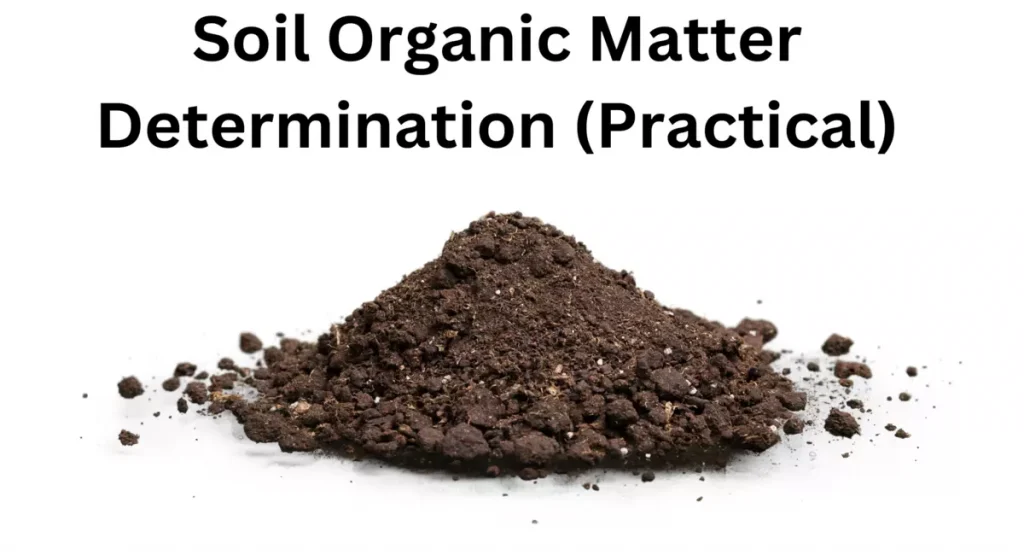Soil organic matter (SOM) represents the remains of roots, plant material, and soil organisms in various stages of decomposition and synthesis, and is variable in composition. “Soil Organic Matter Determination” Though occurring in relatively small amounts in soils, organic matter (OM) has a major influence on soil aggregation, nutrient reserve and its availability, moisture retention, and biological activity.

Soil Organic Carbon (SOC) ranges from being the dominant constituent of peat or muck soils in colder regions of the world to being virtually absent in some desert soils. Cultivated, temperate-region soils normally have often than 3 – 4 % SOM, while soils of semi-arid rainfed areas, such as in the WANA region, have normally less than 1.5 % SOM.
Most laboratories in the region perform analysis for SOM, which can be measured by. either the
loss after ignition method, i.e., weight change destruction of organic compounds by H2O2 treatment
or by ignition at high temperatures, or by wet combustion analysis of soils by chromic acid digestion,
which is the standard method for determining total C.
Also, organic matter/organic carbon can be estimated by volumetric and colorimetric methods. However, the most common procedure involves the reduction of potassium dichromate (K2Cr2O7) by OC compounds and subsequent determination of the unreduced dichromate by oxidation-reduction titration with ferrous ammonium sulfate. This method is referred to as the Walkley-Black method (Walkley, 1947; FAO, 1974).
While the actual measurement is of oxidizable organic carbon, the data are normally converted to
percentage organic matter using a constant factor, assuming that OM contains 58% organic carbon.
However, as this proportion is not in fact constant, we prefer to report results as oxidizable organic
carbon or multiplied by 1.33 as organic carbon.
Apparatus
Magnetic stirrer and Teflon-coated magnetic stirring bar Glassware and pipettes for dispensing and preparing reagents Titration apparatus (burette).
Reagents
- Potassium Dichromate Solution (K2Cr2O7), 1N Dry K2Cr2O7 in an oven at 105 °C for 2 hours. Cool in a desiccator (silica gel), and store in a tightly stoppered bottle. Dissolve 49.04 g K2Cr2O7 in DI water, and bring it to 1-L volume.
- Sulfuric Acid (H2SO4) concentrated (98 %, sp. gr. 1.84)
- Orthophosphoric Acid (H3PO4), concentrated
- Ferrous Ammonium Sulfate Solution [(NH4) 2SO4.FeSO4.6H2O], 0.5 M Dissolve 196 g ferrous ammonium sulfate in DI water, and transfer to a 1-L flask, add 5 m concentrated H2SO4, mix well, and bring to volume.
- Diphenylamine Indicator (C6H5)2NH Dissolve 1 g diphenylamine indicator in 100 mL concentrated H2SO4.
Procedure
- Weigh 1 g air-dry soil (0.15 mm) into a 500-mL beaker.
- Add 10 mL 1 N potassium dichromate solution using a pipette, and add 20 mL concentrated
- H2SO4 using a dispenser, and swirl the beaker to mix the suspension.
- Allow standing for 30 minutes.
- Add about 200 mL DI water, then add 10 mL concentrated H3PO4 using a dispenser, and
allow the mixture to cool
Add 10 – 15 drops of diphenylamine indicator, add a Teflon-coated magnetic stirring bar, and place the beaker on a magnetic stirrer
- Titrate with 0.5 M ferrous ammonium sulfate solution, until the color changes from violet-
blue to green.
- Prepare two blanks, containing all reagents but no soil, and treat them in exactly the same
way as the soil suspensions.
Calculations :
Technical Remarks
- The conversion factor for organic carbon to total organic matter for surface soils varies from
1.7 to 2.0. In the soils of arid and semi-arid regions; a value of 1.724 (=1/0.58) is commonly used. The factors 1.334 and 1.724 used to calculate TOC and OM are approximate and may vary with soil depth and between soils. - For soils high in OM (1 % oxidizable OM or more), more than 10 mL of potassium dichromate is
needed.
- Soils containing large quantities of chloride (Cl), manganese (Mn) and ferrous (Fe) ions give
higher results. The Cl interference can be eliminated by adding silver sulfate (Ag2SO4) to the
oxidizing reagent. No known procedure is available to compensate for the other
interferences. - The presence of CaCO3 up to 50 % of the sample weight causes no interferences.
- The Walkley-Black method for the determination of SOC in soils gives about 89% recovery of carbon as compared to the dry combustion method. The conversion factor 0.336 was
obtained by dividing 0.003, the milli-equivalent weight of carbon, by 89% and multiplying by
100 to convert to a percentage. Chloride interference is eliminated by the addition ofsilver sulfate to the digesting acid as indicated. The presence of nitrates and carbonates up to 5 % and 50 %, respectively, do not interfere.
